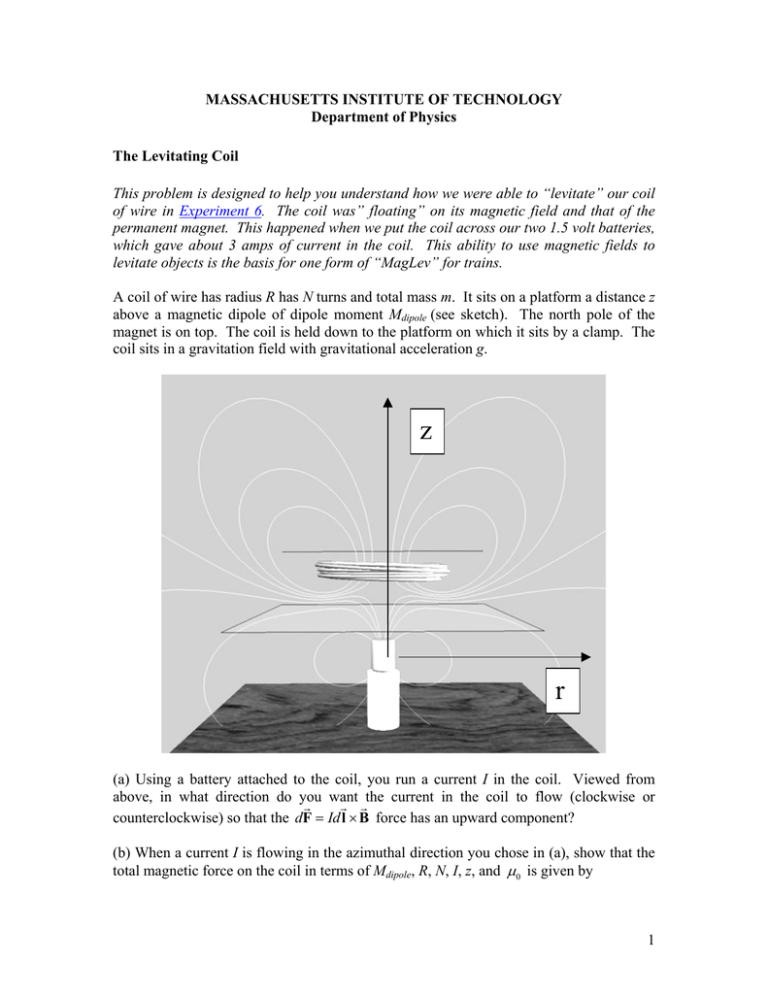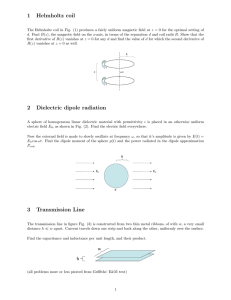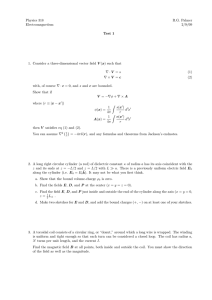MASSACHUSETTS INSTITUTE OF TECHNOLOGY Department of Physics The Levitating Coil
advertisement

MASSACHUSETTS INSTITUTE OF TECHNOLOGY Department of Physics The Levitating Coil This problem is designed to help you understand how we were able to “levitate” our coil of wire in Experiment 6. The coil was” floating” on its magnetic field and that of the permanent magnet. This happened when we put the coil across our two 1.5 volt batteries, which gave about 3 amps of current in the coil. This ability to use magnetic fields to levitate objects is the basis for one form of “MagLev” for trains. A coil of wire has radius R has N turns and total mass m. It sits on a platform a distance z above a magnetic dipole of dipole moment Mdipole (see sketch). The north pole of the magnet is on top. The coil is held down to the platform on which it sits by a clamp. The coil sits in a gravitation field with gravitational acceleration g. z r (a) Using a battery attached to the coil, you run a current I in the coil. Viewed from above, in what direction do you want the current in the coil to flow (clockwise or G G G counterclockwise) so that the dF = Id l × B force has an upward component? (b) When a current I is flowing in the azimuthal direction you chose in (a), show that the total magnetic force on the coil in terms of Mdipole, R, N, I, z, and µ 0 is given by 1 G 2π RNI µo M dipole ⎡ 3Rz ˆ ⎢ F( z ) = k 2 ⎢ R + z2 4π ⎣ ( ) ⎤ ⎥ 5/ 2 ⎥ ⎦ To get this expression you must argue that the component of the force perpendicular to the z-axis vanishes by symmetry, and you will need to know that the magnetic field of a magnet with dipole moment Mdipole in cylindrical coordinates is given by G µo M dipole B(r , z ) = 4π ⎡ 3rz ⎢rˆ ⎢ r2 + z2 ⎣ ( ( 2 z − r ) ⎤⎥ ( r + z ) ⎥⎦ 2 ) 5/ 2 + kˆ 2 2 2 5/ 2 where r is the cylindrical radius. (to see a grass seeds representation of the field given above, go to the Mapping Fields applet, go to the pull down Examples menu, and choose Dipole in no field,). (c) If you release the clamp, the coil will move upwards as long as the current I it carries is greater than a certain amount. What is the minimum current Imin required for the coil to move upward when it is released, in terms of m, g, R, Mdipole, N, z, and µ 0 ? (d) Take m to be 20 g, Mdipole to be 10 A ⋅ m 2 , g to be 9.8 m/s2, N = 30 turns, R = 50 mm and z=50 mm. What is the numerical value of Imin in part (c) above for these parameters? (e) Suppose you wanted to get the coil twice as high as in part (d), e.g. to 100 mm. What is the current necessary to lift the coil up to z = 100 mm? You can see if you have the correct current in both (d) and (e) by going to the Levitating Coil applet and inserting the numerical values of the currents you calculate for these two cases. In this applet, a positive value of the current means that the current in the coil is circulating clockwise as seen from above, and vice versa. The platform in the applet is at 50 mm, and we have put in a marker line at 100 mm. You can set the current in the coil at the value you want, and then hit play to see if the coil will levitate for that value of the current. We have some damping in the applet so that the coil will eventually settle down to a steady position for a given current after a bit. 2





